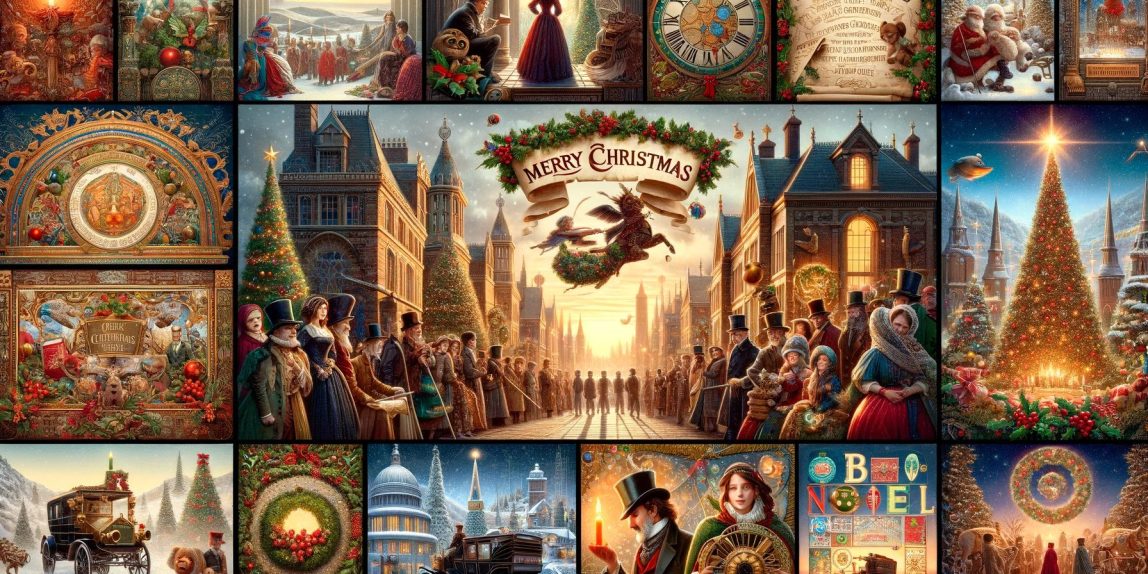The festive season of Christmas is not just a time for gifts and feasting; it’s also a season rich in traditions and greetings. Among these, phrases like “Merry Christmas,” “Bon Noel,” and “Season’s Greetings” resonate with warmth and joy. But where did these popular greetings originate, and how have they evolved over time? Let’s unwrap the history behind these familiar phrases.
“Merry Christmas”: A Journey from the Middle Ages to Dickens
The greeting “Merry Christmas” has a storied history, dating back to the Middle Ages. Originally, the word “merry” didn’t just mean cheerful; it also implied peacefulness and blessedness. The earliest known written use of “Merry Christmas” can be traced to a 16th-century English carol, which espoused the sentiment of joy and goodwill.
However, it was in the 19th century, particularly through Charles Dickens’ “A Christmas Carol,” that “Merry Christmas” cemented its place in the popular lexicon. Dickens’ portrayal of a festive, joyful Christmas played a significant role in shaping how the holiday was celebrated, particularly in Victorian England. His use of “Merry Christmas” in the novel was more than a greeting; it was a symbol of hope, transformation, and the spirit of giving.
“Bon Noel”: French Elegance in Festive Wishes
“Bon Noel,” translating to “Good Christmas,” is a traditional French greeting. The French have a rich history of celebrating Christmas, or “Noel,” which is believed to derive from the French phrase “les bonnes nouvelles,” meaning “the good news.” This refers to the Gospel’s good news. In France, Christmas is a time of family gatherings and church services, where “Bon Noel” is commonly exchanged, resonating with the warmth and familial bond of the season.
The use of “Bon Noel” spread with the influence of French culture across Europe and into the New World. It’s a greeting that carries with it a sense of elegance and history, reflective of France’s deep cultural roots in the Christmas celebration.
“Season’s Greetings”: An Inclusive and Global Wish
“Season’s Greetings” is a more modern and inclusive phrase that gained popularity in the late 19th and early 20th centuries. As societies became more diverse, and with the acknowledgment of different cultural and religious practices during the winter season, “Season’s Greetings” emerged as a neutral, inclusive way to express well wishes.
This phrase is particularly popular in a corporate and public setting, where it’s important to acknowledge the diversity of beliefs and traditions. It’s a greeting that transcends religious boundaries, offering a universal message of goodwill during the holiday season.
Other Notable Mentions
- “Feliz Navidad”: This Spanish phrase, meaning “Happy Christmas,” is widely used in Spain and Latin American countries. Its popularity surged globally with the famous Christmas song by José Feliciano in 1970.
- “Frohe Weihnachten”: A traditional German greeting, meaning “Merry Christmas,” reflective of Germany’s rich Christmas traditions, including the famous Christmas markets.
- “Buon Natale”: The Italian version of “Merry Christmas,” echoing Italy’s deep-rooted Christian traditions and the importance of the holiday in Italian culture.
The Evolution of Christmas Greetings in a Digital Age
In the digital era, Christmas greetings have taken on new forms. E-cards, social media posts, and even animated messages have become popular. These digital greetings often incorporate traditional phrases but present them in innovative, interactive formats.
The essence of these greetings, however, remains unchanged. Whether it’s a hand-written card or a digital message, the core sentiment of spreading joy, peace, and goodwill continues to be the heart of these festive phrases.
A Continuum of Joy and Goodwill
The history of Christmas greetings is a fascinating journey through time and culture. Phrases like “Merry Christmas,” “Bon Noel,” and “Season’s Greetings” have not only endured but have also adapted to changing times, reflecting the enduring spirit of the holiday season. They connect us to our past, celebrate our present, and carry forward the timeless message of joy, peace, and goodwill to all. As we exchange these familiar phrases each year, we’re not just sharing words; we’re part of a historical tapestry, woven through centuries of tradition and celebration.
